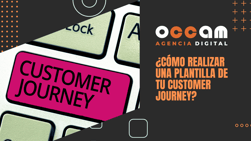Index Content
The customer journey is the buyer's path, a graphic way of reflecting the path that a person takes from the moment they internally recognise a need until they make a purchase, if they finally do so. It is one of the main elements of Inbound Marketing and one of the aspects that is most taken into account when creating personalised marketing strategies. For example, to segment databases or devise marketing strategies, lead nurturing... This path has different stages, the so-called customer journey moments.
However,the speed and automation of processes thanks to the internet and mobile devices (especially the latter) has accelerated the process so much that we now speak of "micro-moments" .
The moments of the customer journey
As a company, it is our internal responsibility to know at which stage of the customer journey each person is in order to act in the most appropriate way. The three main moments a person goes through when buying a product or service are: recognition, consideration and decision.
- Recognition: At this stage, the future customer recognises a need, problem or opportunity. Therefore, he/she starts a search and research to identify specifically what that need is. For this reason, educational resources are sought, above all. Chatbots or any conversational tool that can provide information is a useful resource for this moment as it could speed up the process.
- Consideration: The prospect has already clearly defined their problem and is willing to research, understand and find a solution. People going through this stage want to look for specific information about your company to decide if it is the best option for the specific need. As a company, you can respond with active and direct channels such as Messenger or WhatsApp.
- Decision making: In this last stage, the prospect has defined a strategy or a way to solve their problem. They have made a decision after, most likely, making a list of all the suppliers and products that are similar to their need.
Of course, not all customers end up becoming customers. There are times when the whole journey is not completed, either due to lack of information, not finding exactly what they are looking for or postponing the purchase. However, it is part of the company's responsibility, as we said, to accompany people on the journey so that they get as much information as possible and continue the journey motivated until they make a purchase with which they become customers.
It is also possible that some of these customers do not start the journey with you and that they appear on your company's radars with the journey already begun. This can happen either because they come across your brand close to the moment they make a decision, or because they resume a search they have already started but abandoned.
Use the information about where your prospects are, how they prefer to communicate and which channels are best for your team, and you will be able to make more informed decisions when implementing a growth strategy with conversational marketing.
The micro-moments of the customer journey
The leap from "moments" to "micro-moments" occurs, as we said, as a result of the acceleration of all processes with technological action. The acceleration of the journey translates into a compression of all stages that makes them come to be considered, metaphorically, micro-processes.
The presence of computers or mobile devices means that the moment they experience, in concrete terms, is directly the most important moment in the customer journey.
The customer journey is now considered to continue after the purchase, which is why the latest trends are coming to consider this process a cycle and not so much a timeline. The same technology allows another moment to exist, for example, an evaluation of the purchase or experience. The key now is to be present, more than ever, in each of the environments where the consumer might find themselves when they feel that need, which can now be satisfied so immediately .
The relationship between technology and micro-moments is specifically evident with the mobile phone. It is by far the device we use the most. However, we do not use it for long periods, but for very short periods of time that are constantly repeated. This is another reason why it has ended up being christened micro-moments. In those fleeting glances at the phone, however, we do many things, because we have the possibility of carrying them out almost immediately. That is why it is considered that there are 4 types of micro-moments generated by this availability of the phone.
- I want to see: This refers to those moments in which we unlock the phone with the aim of browsing, looking without wanting to buy or looking for resources about something that interests us. It is, for example, the moment in which we look at an online catalogue of clothes, cheap flight destinations, or restaurants to go to next weekend.
- I want to know: Resources for learning something, e.g. online encyclopaedias, bibliographic resources.
- I want to do: Instructions or tutorials to learn how to do something, e.g. a manicure, a craft, to assemble an appliance or furniture...
- I want to buy: They are looking for information about products or services they want to buy.
It might seem that the only moment that really applies to the buyer's journey is the last one. However, the rest of the micro-moments make up a small part of the first stages of the buyer's journey. A need to buy can arise after a concern, for example, the need to buy an urban garden can arise after having informed yourself about the pesticides used by large food companies. As a company, it is important to keep these new micro-moments in mind and diversify your offers and resources on your pages and social networks as much as possible, so that prospects can turn to you in any of them.
As we said, these are small spaces of time, sometimes we are not even on the phone for two minutes, but the reality is that if a user has come to your website for information or to consult offers, it is very likely that they will return to it in the micro-moment "I want to buy", one of the most decisive.
Previously, we talked about "phases", long periods of time where options were considered slowly, spending time exploring each one of them. However, the current need for immediacy (and the opportunity to achieve it) forces us to slightly transform the conception of these phases to moments of "I want this" .
However, the term micro-moments is not only applied because of the smaller temporal compression of moments, but also because it refers to moments, within moments, when key decisions are made. They are small needs within needs. For example, getting to a road without passing through toll booths, buying a T-shirt that is made of organic cotton, or getting a reservation at a restaurant without having to phone.
Without the presence of filters, or without participating in applications that facilitate and shorten these actions, such as hotel booking applications, you can lose these potential customers who want to automate and specify the process at another level.
For a good strategy of moments and micro-moments, it is essential to set specific and timely objectives for each of these moments that help the prospect to achieve these goals and move to the next stage. It is essential, at the same time, to offer value at each of the stages so that the prospect leaves enriched from each of the phases.




